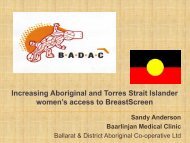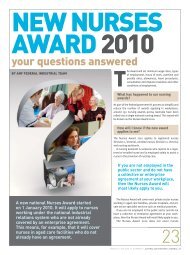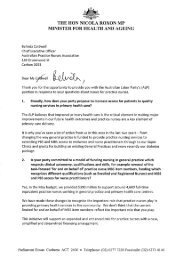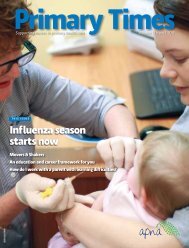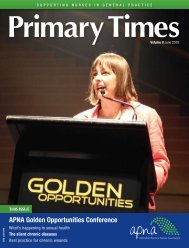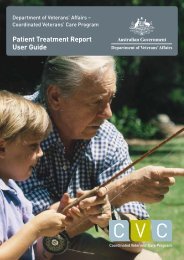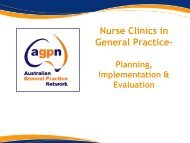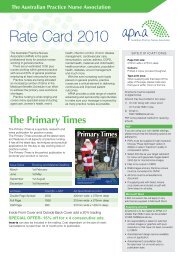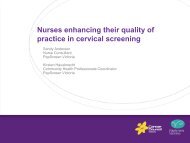Background Literature Review Research Aims Methodology ... - APNA
Background Literature Review Research Aims Methodology ... - APNA
Background Literature Review Research Aims Methodology ... - APNA
You also want an ePaper? Increase the reach of your titles
YUMPU automatically turns print PDFs into web optimized ePapers that Google loves.
5/3/2010Kathy GodwinRN, A&E Cert, BHSc (Nursing), Grad Cert (Nursing), CandidateMaster Nursing -<strong>Research</strong> <strong>Background</strong> <strong>Literature</strong> <strong>Review</strong> <strong>Research</strong> <strong>Aims</strong> <strong>Methodology</strong> Findings and Discussion Conclusion Acknowledgements Personal nursing experiences Hospital based-Emergency & critical care Rural and urban communities Nursing in General Practice Initiative (DoHA 2006) to relieve GP workforce shortages Improve patient access to care Improve care quality Integrate PHC nursing: disease prevention and healthpromotion1
5/3/2010 In order to investigate how rural practicenursing can be sustainable, I asked: What affects the retention of rural practicenurses?Key Search terms include:Practice nurse RetentionNurse RetentionAustralian Rural Nurs$General practice nursingRural Nurse Satisfaction Database’s Used:CINAHL,SAGE,MEDLINE,Proquest,Expanded Academic ASAP, andMeditext2
5/3/2010 Four main themes:1. Nursing in the rural context2. The integration of nursing into general practice3. Practice competency4. Practice supportNursing in the rural context: Traditional rural nursing:Community centre & hospital based nursing (Hegney 2007) Rural GP service needs different to urban:Fewer services and dhealth lhprofessionalsGreater distance for services (Weymouth et al 2007; Hays et al 1997) Working in own community:Health workers enjoy rural lifestyle (Harding et al 2006; Hegney et al 2002;Hays et al 1997)Disliked loss of anonymity (Hegney et al 2002; Hayes et al 1997)The integration of nursing into general practice• PN workforce stats: 45% rural, approx. 1:3 work solo PN, older(AGPN 2007)• PN role has “ clinical, educative, administrative and supportivecomponents” (Patterson et al 2005, p.49)• PN preparedness does not always match GP & consumerexpectations (Cross 2006; Cheek et al 2002)• Disparity -in nurse autonomy within collaborative team care (Millsand Fitzgerald 2008; Patterson et al 2007)-between nurse autonomy and Medicare( Phillips et al 2007; Halcomb et al 2006; Willis et al 2000)3
5/3/2010 Practice nurse competency• Extended role expectations do not always match nursesscope of practice ( Halcomb et al 2008;Cross 2006,; Halcomb 2006)• Knowledge transfer barriers exist for PN education andtraining i (Hall 2007;Pascoe et al 2006; Meadley et al 2004)• Undefined professional boundaries raised problems withmedico-legal ambiguity (Murray & Wronski 2006; AGPN 2006; Nowark & Bickley2005) Practice nurse support• Remuneration for PN lower:• averages less than other awards causing dissatisfaction (<strong>APNA</strong> 2007;Halcomb et al 2007)• Problem with leave relief (Hall et al 2007)• Little financial support for rural PN:• little $ incentives for rural & remote nurses, compared to GP’s(incl. relocation support, trave to see family, education(NHRA 2002)• Rural PN can be eligible for <strong>APNA</strong> scholarships(<strong>APNA</strong> 2008)• Healthcare policy needs to empower PN profession- PN seek career structure for progressive career progression (<strong>APNA</strong>2008; Halcomb et al 2005)Limitations in current research and gaps inthe literature No research studies solely on Aust. rural PNs More Australian PN research needed. Minimal research involving rural Aust. PNsexploring:• Social issues in relation to job satisfaction.• Professional issues in relation to job satisfaction4
5/3/2010 To investigate why rural practice nurses continue inthe Australian workforce. To identify the social aspects that affects ruralpractice nurse retention. To identify professional aspects that affect ruralpractice nurse retention. <strong>Research</strong> explored the social and professional issues thataffect rural practice retention. Qualitative method with a grounded theory approach, withsemi-structured interviews. Ethics approval HREC University of Wollongong in September2008. Rural practice nurses recruited through Division of General P ractice (RRMA 4). 58 eligible PNs, 22 volunteers. Semi structured interviews of approx 30 mins recorded andtranscribed. Transcriptions coded into categories and then themes, withthe assistance of NVivo software. Practice nurses interviewed until data saturation was reachedafter 7 interviews.5
5/3/2010 Three (3) main themes:1. Professional relationships2. Scope of practice3. Making money.6
5/3/2010 Professional Relationships Community acceptance of the practice nurse Collaborative care with the GP Other professional relationships7
5/3/2010Community acceptance of the PN role“biggest drawcard..quality of life with my family”“ I grew up around here...I think I will always be in a similarrural setting”“important for these people, getting to know me,building a rapport .... they need to learn to trust me...Its notjust being the nurse, or that nurse, .... I feel that it is part ofbeing in the community”Collaborative care with the GP“I don’t think I’d want anything to go wrong or else I would beout tomorrow, but while everything’s going good, its nice, it’ssupportive”“its good, we have a nice team,... we all work together” Establishing professional relationships Barriers for access to education and training The challenges of advanced d care roles8
5/3/2010Establishing a professional identity in generalpractice“..even though I wasn’t the doctor...I’m an extension of hisarm and people would look to me providing much the sameservice”“...the way you deal with people...being able to multitask,assessing things on the flight, its not just about being anurse; it’s about being a bit of everything aswell”Barriers for access to education and training‘”...he showed me a lot and taught me how to do procedures,and ECG’s and stuff”“I ‘m so incredibly frustrated by, lack of support...lack of timefor studying, ..lack of understanding as to what my roleactually is, lack of job description...”“we do a lot of workshops ...in the evening...they don’t have topay or anything”The challenge of advanced care roles“ We do triage..a lot of the time...because the hospital here,there’s actually not a doctor on duty at he thehospital.....emergency patients come to ...to the local GP”“Probably the emergencies are a bit of a challenge for mebecause with my community health background...”“we have to keep learning. If you don’t you might as wellleave”9
5/3/2010 Understanding the business of private healthcare Time is money: the impact of time restraints onnursing care Accommodating the practice nurse: Practicefacilities and equipment Practice nurse remunerationUnderstanding the business of privatehealthcare“...in the hospital you just do...do what you have to do for yourroutine shift...where as here...even even though we do ..we have towait for the doctor to see the patient”Time is money: the impact of time restraintson nursing care“works on appointments..10minute consults unless specialarrangements negotiated for the nurse time..financially..theyhave a model...in the hospital it is all floating around in theether........and then fit ins, you have to see those patients atthat time...so sometimes you feel pushed for time...especiallywhen you are trying to educate chronic diseases”10
5/3/2010Accommodating the nurse: Practice facilitiesand equipment“we are the last to be considered for financial things likeworkspace, ..equipment and its just really frustrating to feellike you are not even part of the team......it makes you feellike the work you are doing isn’t appreciated”Practice nurse remuneration“I have no idea really, how many holidays (are) up my sleeve”“..I feel sorry for the girls who don’t get the award wages arehalf that of a state RN..you get more than that in Woolliesstacking shelves” Family friendly rural lifestyle & hours (new) Enjoy community recognition (new) Collaborative care decision making Professional respect from GP Diversity i in daily workloads Has support for education Adequate nurse workspaces & equipment11
5/3/2010 Time restraints Heavy workloads Lack of professional autonomy Low remuneration Lack of education support Inadequate workspace Financial Hardship Task orientated workloads Medico-legal ambiguity Professional preparedness (esp. ruralemergency care) )(new) Unclear leave entitlements (new)Subjective analysis despite using software inanalysisResults of findings cannot be generalized to allrural PNs.These findings captured the thoughts and feelingsof this small cohort of rural PNs at a particularpoint in time.However, the findings provide insight forpolicymakers.12
5/3/2010 Support flexible employment arrangements withfamily friendly hours. Support local education specific to communityneeds. Maintain ongoing government support for PNeducation and professional career structure . Subsidise PN specific infrastructure. Provided an overview of the background,the literature and the methodology. The Findings and Discussion identifiedthree main themes: Professional relationships Scope of Practice Making Money Strategies for consideration were identified.Rural PN participantsAustralian Practice Nurses AssociationNSW Alliance of General PracticeSupervisors (UOW);Associate Professor Janette CurtisMs Yvonne WhiteProfessor Patrick Crookes (UOW)My family; husband and 2 daughtersMy community: my colleagues, friends and patients,who continually encourage me!13
5/3/2010Australian General Practice Network (AGPN) 2006, Nursing in general practice recruitment andorientation resource, AGPN, Manuka, ACT. Australian General Practice Network (AGPN) 2007, ‘National Practice Workforce Survey Report 2007’,AGPN, Manuka, ACT.Australian Practice Nurse Association (<strong>APNA</strong>) 2008, ‘Submission to the National Health and HospitalsReform Commission’, 30 May, 2008. <strong>APNA</strong>, Melbourne, VIC.Cheek, J, Price, K, Dawson, A, matt, K, Beilby, J & Wilkinson, D 2002, Consumer Perceptions of Nursingand Nurses in General Practice. Centre for <strong>Research</strong> into Nursing and Health Care (CRNHC), Universityof South Australia.Cross, S 2006, ‘Practice potential: the expansion of general practice nursing offers a range of new andexciting career options’, Nursing Standard, vol 20, no. 43, pp. 70-71.Department of Health and Ageing ( DoHA) 2006, ‘Nursing in general practice training and supportinitiative 2005-2009’ Canberra, viewed 25 February 2008.Halcomb, EJ, Davidson, PM, Daly, JP, Griffiths, R, Yallop, J & Tofler, G 2005, ‘Nursing in Australiangeneral practice: directions and perspectives’, Australian Health <strong>Review</strong>, vol. 29, no 2, pp. 156-166.Halcomb, E, Davidson, PM, Salamonson,Y, Ollerton, R & Griffiths, R 2008. ‘Nurses in Australian generalpractice: implications for chronic disease management’, Journal of Clinical Nursing, vol 17 5a, pp. 6-15.Halcomb, E, Davidson, PM, Yallop, J, Griffiths, R & Daly, J 2007 , ‘Strategic directions for developing theAustralian general practice nurse role in cardiovascular disease management’, Contemporary Nurse,vol. 26, no. 1, pp.125-135.Harding, A, Whitehead, P, Aslani, P & Chen, T 2006, ‘Factors affecting the recruitment and retention ofpharmacists to practice sites in rural and remote areas of New South Wales: A qualitative study’,Australian Journal of Rural Health, vol 14, pp. 214-218.Hall, S 2007, ‘Divisions of general practice and practice nurse development in Australia’, ContemporaryNurse, vol 26, no. 1, pp. 37- 47.Hays, RB, Veitch, PC, Cheers, B & Crossland, L 1997, ‘Why doctors leave rural practice’, AustralianJournal of Rural Health, vol 5, pp. 198-203. Hegney, D 2007, ‘Practice nursing in rural Australia’, Contemporary Nurse, vol. 26, pp. 74-82.Hegney, D, McCarthy, A, Rodgers-Clark, C & Gorman, D 2002(a), ‘Retaining rural and remote areanurses: the Queensland, Australia experience’, Journal of Nursing Administration, vol. 32, no. 3, pp.128-135.Hegney, D, McCarthy, A, Rodgers-Clark, C & Gorman, D 2002(b), ‘Why nurses are attracted to rural andremote practice’, Australian Journal of Rural Health, vol. 10, pp. 178-186.Hegney, D, McCarthy, A, Rodgers-Clark, C & Gorman, D 2002(c),‘Why nurses are resigning from ruraland remote Queensland facilities’, Collegian, vol. 9, no.2, pp. 33-39.Joyce, C, & Piterman, L 2009, ‘Farewell to the handmaiden? :Profile of nurses in Australian generalpractice in 2007’, Australian Journal of Advanced Nursing, Vol. 27, No. 1, pp. 48-58.Meadley, L, Conway, J, & McMillan , M 2004, ‘Education and training needs of nurses in generalpractice’, Australian Journal of Primary Health, vol. 10, no. 1, pp. 21-27.Mills, J & Fitzgerald, M 2008, ‘The changing role of practice nurses in Australia: an action researchstudy’, Australian Journal of Advanced Nursing, Vol. 26, no. 1, pp16-20.14
5/3/2010 Murray, R B & Wronski, I 2006, ‘When the tide goes out: health workforce in rural, remote andIndigenous communities’, Medical Journal of Australia, vol 185, pp. 37-38. Nowak, M & Bickley, M 2005, ‘Nurses’ Voices’, Australian Bulletin of Labour, vol 31, no.4, pp. 407-425.National Rural Health Alliance 2002, ‘Action on nursing in rural and remote areas: A discussion paper’.(Online)http://nrha.ruralhealth.org.au/cms/uploads/publications/7_nursing.pdfPascoe, T, Hutchinson, R, Foley, E, Watts, I, Whitecross, L & Snowdon, T 2006, ‘General practice nursingeducation in Australia’, Collegian, vol. 13, no.2 , pp. 22-25.Patterson, E, Halcomb, E & Davidson, P 2007, ‘Practice nursing in Australia: whose responsibility?’,Collegian, vol. 14, no. 4, pp. 2-3.Patterson, E & McMurray, A 2002, ‘Collaborative practice between registered nurses and medicalpractitioners in Australian general practice: moving from rhetoric to reality’, Australian Journal ofAdvanced Nursing, vol.20, no. 4, pp. 43-48.Phillips, C, Dwan, K, Pearce, C, Hall, S, Porritt, J, Yates, R & Sibbald, B 2007, ‘Time to talk, time to see:changing microeconomies of professional practice among nurses and doctors in Australian generalpractice’, Contemporary Nurse, vol 26, no. 1, pp.136- 144. Weymouth, S, Davey, JC, Wright, JL, Nieuwoundt, LA, Barclay, L, Belton, S, Svenson, S & Bowell, L 2007,‘What are the effects of distance management on the retention of remote area nurses in Australia?’Rural and Remote Health, vol. 7, no. 652 (online), 2007 viewed 31 January, 2008 at www.rrh.org.auWillis, E, Condon, J & Litt, J 2000, ‘Working relationships between practice nurses and generalpractitioners in Australia: a critical analysis’, Nursing Inquiry, vol. 7, pp. 239-247. 24715



